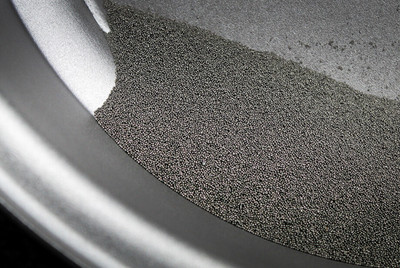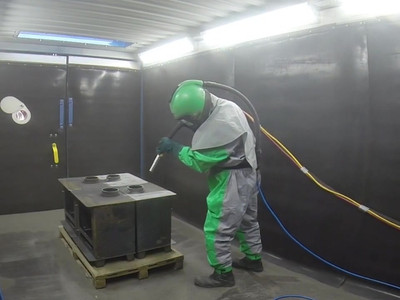9th Oct 2024
Abrasive blasting, also known as sandblasting (an outdated term in the UK), is a powerful surface preparation technique used in various industries. Whether you’re restoring an old piece of machinery, preparing a surface for a fresh coat of paint, or removing rust and corrosion, abrasive blasting offers a wide range of benefits. In this blog, we’ll explore the many useful effects of abrasive blasting and why it’s such a popular choice for surface treatment.
What is abrasive blasting and how does it work?
Abrasive blasting is a process where abrasive media, such as sand, glass beads, or steel shot, is propelled at high speed against a surface. This process strips away unwanted layers, like paint, rust, or grime, to reveal a clean surface underneath. Compressed air or water typically powers the blasting media, making it an efficient way to achieve a smooth, debris-free surface. It can be used for cleaning, smoothing, roughening, and altering the surface's physical properties.
What are the primary uses of abrasive blasting in different industries?
Abrasive blasting has found its way into many industries thanks to its versatility and effectiveness. In construction, it’s used for cleaning and preparing steel beams and other structures. The automotive industry uses it to strip old paint or rust from car bodies before applying new finishes. The marine industry relies on abrasive blasting to remove barnacles, rust, and old paint from ship hulls. Manufacturing and aerospace industries also benefit from using it to prepare surfaces for coatings or improve part performance.
How does abrasive blasting improve surface preparation for coatings or paint?
One of the main advantages of abrasive blasting is its ability to create a perfectly prepared surface for coatings or paint. The process removes contaminants like oils, rust, or old paint that can interfere with coating adhesion. This results in a cleaner, rougher surface that provides better "tooth" for coatings to bond to, leading to a more durable and long-lasting finish.
What materials can be treated with abrasive blasting?
Abrasive blasting is incredibly versatile and can be used on a wide range of materials. These include metals, like steel and aluminium, concrete, wood, glass, and even plastic in some cases. The choice of abrasive media and blasting technique can be tailored to suit the material being treated, ensuring optimal results without damaging the surface.
What are the benefits of using abrasive blasting over other surface preparation techniques?
Compared to other methods like chemical cleaning, grinding, or sanding, abrasive blasting offers several key advantages:
- It’s faster being used on large surfaces.
- It provides a deeper clean, removing contaminants down to the bare surface.
- It can be used on irregular shapes and hard-to-reach areas.
- By increasing the lifespan of coatings and reducing maintenance costs as the coatings bond better to the substrate, abrasive blasting often proves to be the most economical choice in the long run.
How does abrasive blasting contribute to rust and corrosion removal?
Rust and corrosion are major concerns, especially for industries dealing with metals and marine environments. Abrasive blasting is a highly effective solution for rust removal. By stripping away rusted layers and leaving a clean, smooth surface behind, abrasive blasting not only improves the appearance but also extends the life of the equipment or structure.
What environmental or safety precautions should be considered during abrasive blasting?
Abrasive blasting requires strict safety and environmental precautions. The process generates dust and debris, which may contain hazardous materials. To reduce risks, proper containment, such as blast booths or blast rooms, should be used, and workers must wear PPE, including helmet respirators, protective suits and footwear, and blast resistant gloves. Noise and vibration hazards also require precautions. Proper ventilation and worker training are essential, and spent abrasive materials must be disposed of following hazardous waste regulations. Using eco-friendly media and methods like wet blasting can further minimise environmental and health impacts.
What types of abrasive media are commonly used, and how do they affect the outcome?
The type of abrasive media used in blasting can significantly affect the outcome. Some of the most common types of media include:
- Aluminium oxide
- Glassia
- Steel shot
- Steel grit
- Glass bead
- Walnut shell
Choosing the right media depends on the material and the desired finish, ensuring that the blasting process meets the specific needs of the project. You can see our full range of abrasive media available online here, or for more guidance on which media you should select, you can see our Abrasives & Media brochure here.
What impact does abrasive blasting have on the longevity and durability of the treated surface?
By thoroughly cleaning and roughening the surface, abrasive blasting enhances the adhesion of coatings or paints, improving the surface's resistance to wear, corrosion, and weathering. This extends the lifespan of both the treated material and the protective coatings applied afterward, reducing maintenance costs and extending the time between necessary repairs.
Are there eco-friendly or sustainable abrasive blasting options available?
With growing environmental concerns, more sustainable abrasive blasting methods are becoming available. Eco-friendly media like recycled glass or biodegradable materials can replace traditional sand, reducing waste and minimising environmental impact. Additionally, techniques like wet blasting can help contain dust and reduce the spread of hazardous particles, making the process safer and more environmentally friendly.
Conclusion
Abrasive blasting is a versatile, efficient, and highly effective method for surface preparation and restoration. From removing rust to prepping for new coatings, the useful effects of abrasive blasting can be seen across a wide range of industries and materials. Whether you’re looking for speed, efficiency, or durability, abrasive blasting offers a reliable solution to enhance the longevity and appearance of surfaces.




